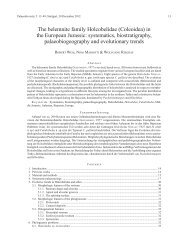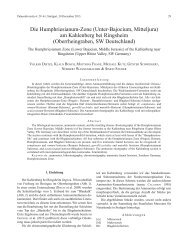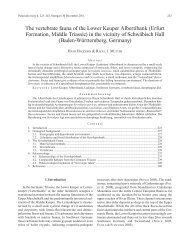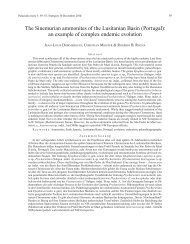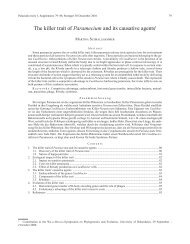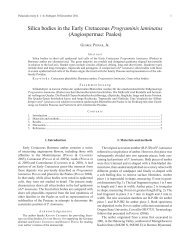The future of supertrees: bridging the gap with ... - Palaeodiversity
The future of supertrees: bridging the gap with ... - Palaeodiversity
The future of supertrees: bridging the gap with ... - Palaeodiversity
You also want an ePaper? Increase the reach of your titles
YUMPU automatically turns print PDFs into web optimized ePapers that Google loves.
<strong>Palaeodiversity</strong> 3, Supplement: 99–106; Stuttgart 30 Decenber 2010. 99<br />
<strong>The</strong> <strong>future</strong> <strong>of</strong> <strong>supertrees</strong>: <strong>bridging</strong> <strong>the</strong> <strong>gap</strong> <strong>with</strong> supermatrices 1<br />
OLAF R. P. BININDA-EMONDS<br />
Abstract<br />
<strong>The</strong> supertree and supermatrix frameworks have been cast as mutually exclusive approaches toward <strong>the</strong> problem<br />
<strong>of</strong> large-scale phylogenetic inference. Despite <strong>of</strong>ten coming under severe criticism, <strong>the</strong> supertree approach has<br />
proven superior to date at deriving comprehensive phylogenetic estimates for many groups (e. g., mammals as a<br />
whole) because by combining trees instead <strong>of</strong> characters, it is able to include more <strong>of</strong> <strong>the</strong> global phylogenetic database.<br />
<strong>The</strong> continued rapid growth in sequencing technologies, however, means that this advantage is time-limited<br />
given that abundant sequence information will rapidly become available for many groups. What <strong>the</strong>n does such<br />
a <strong>future</strong> hold for <strong>the</strong> supertree approach In this paper, I argue that <strong>the</strong> supertree framework could continue to have<br />
a place in phylogenetic inference, albeit altered to play a subordinate role as part <strong>of</strong> a divide-and-conquer heuristic<br />
search strategy for large molecular supermatrices. However, <strong>the</strong> divide-and-conquer approach has yet to realize<br />
its <strong>the</strong>oretical advantages (in terms <strong>of</strong> both speed and accuracy) over more conventional heuristic search strategies.<br />
I discuss two potential supertree-related bottlenecks that appear to be limiting <strong>the</strong> performance <strong>of</strong> <strong>the</strong> divide-andconquer<br />
approach and which can be viewed as problems for which solutions need to be sought.<br />
K e y w o r d s : Supertree, supermatrix, phylogenetic inference.<br />
Zusammenfassung<br />
Supertree- und Supermatrix-Systeme entstanden als sich gegenseitig ausschließende Analysemethoden des<br />
Problems umfangreicher phylogenetischer Untersuchungen. Trotz zahlreicher Kritik hat sich die Supertree-Methode<br />
als überaus erfolgreich beim Erstellen sehr großer phylogenetischer Datensätze (z. B. Säugetiere) erwiesen, da<br />
durch die Kombination von Stammbäumen statt von Merkmalen Informationen aus der globalen phylogenetischen<br />
Datenbank einbezogen werden können. Dieser methodische Vorteil nimmt jedoch in dem Maß ab, wie die Datenmenge<br />
genetischer Sequenzen zunimmt, die in kürzester Zeit für immer mehr Gruppen zur Verfügung stehen. Was<br />
bedeutet diese Zunahme an Sequenzdaten für die Zukunft der Supertree-Analyse Im Folgenden argumentiere ich,<br />
dass Supertrees für phylogenetische Analysen weiterhin relevant bleiben, wenngleich sie nur noch eine untergeordnete<br />
Rolle als Teil eines Divide-and-Conquer-heuristischen Verfahrens für große molekulare Supermatrices spielen<br />
werden. Die zumindest <strong>the</strong>oretisch vorhandenen Vorteile (wie z. B. Geschwindigkeit und Genauigkeit) dieser<br />
Divide-and-Conquer Verfahren gegenüber konventionellen heuristischen Methoden müssen sich jedoch in der Praxis<br />
noch bewähren. Im Folgenden diskutiere ich zwei mögliche, durch die Supertree-Analyse entstehende Probleme,<br />
welche die Effizienz von Divide-and-Conquer-Verfahren limitieren, und zu deren Lösung neue Strategien entwickelt<br />
werden müssen.<br />
Contents<br />
1. Introduction ...........................................................................................................................................................99<br />
2. Supertrees, supermatrices, and global congruence ............................................................................................ 101<br />
3. Dividing and conquering: <strong>supertrees</strong> as a heuristic search tool ........................................................................102<br />
4. Conclusions .........................................................................................................................................................104<br />
5. References ........................................................................................................................................................... 105<br />
1. Introduction<br />
Since <strong>the</strong> first large-scale supertree <strong>of</strong> Primates was<br />
published by PURVIS (1995), supertree construction has<br />
proven itself to be a highly useful method for constructing<br />
large, comprehensive phylogenetic trees for a wide variety<br />
<strong>of</strong> organismal groups. Indeed, many <strong>of</strong> <strong>the</strong> published<br />
<strong>supertrees</strong> represented <strong>the</strong> first complete phylogenetic estimates<br />
for <strong>the</strong> groups in question (for a now outdated list,<br />
see BININDA-EMONDS 2004a) and, in many cases, remain<br />
<strong>the</strong> only such estimates.<br />
Despite <strong>the</strong>ir utility, <strong>supertrees</strong> never<strong>the</strong>less have<br />
been strongly criticized by many (e. g., NOVACEK 2001;<br />
S PRINGER & DE JONG 2001; GATESY et al. 2002; GATESY &<br />
SPRINGER 2004) and <strong>the</strong>re has been much heated debate<br />
about <strong>the</strong> relative merits <strong>of</strong> <strong>the</strong> supertree and supermatrix<br />
1<br />
Contribution to <strong>the</strong> WILLI-HENNIG-Symposium on Phylogenetics and Evolution, University <strong>of</strong> Hohenheim, 29 September –<br />
2 October 2009.
100 PALAEODIVERSITY 3, SUPPLEMENT, 2010<br />
frameworks <strong>of</strong> phylogenetic inference (see <strong>the</strong> exchange<br />
between myself and JOHN GATESY in particular: GATESY<br />
et al. 2002; BININDA-EMONDS et al. 2003; BININDA-EMONDS<br />
2004b; GATESY et al. 2004). Criticisms <strong>of</strong> <strong>supertrees</strong> range<br />
from shortcomings in specific implementations <strong>of</strong> <strong>the</strong><br />
method to perceived shortcomings that are fundamental<br />
to <strong>the</strong> method itself. Among <strong>the</strong> latter, <strong>the</strong> key concern is<br />
that <strong>supertrees</strong>, by combining and analyzing <strong>the</strong> trees derived<br />
from character data ra<strong>the</strong>r than analyzing <strong>the</strong> data<br />
directly, represent a meta-analysis one step removed from<br />
<strong>the</strong> real data (GATESY & SPRINGER 2004). <strong>The</strong> inherent loss<br />
<strong>of</strong> information this fact entails automatically translates for<br />
some to an inherent decrease in accuracy compared to a<br />
supermatrix analysis. Instead, <strong>the</strong> meta-analysis nature <strong>of</strong><br />
<strong>supertrees</strong> can also be viewed as a potential strength. Because<br />
issues <strong>of</strong> character data combinability do not affect<br />
supertree construction, more <strong>of</strong> <strong>the</strong> total phylogenetic database<br />
can be used to derive <strong>the</strong> evolutionary trees. This<br />
fact, in large measure, accounts for <strong>the</strong> ability <strong>of</strong> <strong>supertrees</strong><br />
to obtain more comprehensive phylogenetic trees for<br />
most groups than is currently possible using a supermatrix<br />
approach. Even so, it is held by some that phylogenetic<br />
<strong>supertrees</strong> merely represent a stop<strong>gap</strong> measure for<br />
phylogenetic inference until sufficient molecular data become<br />
available to enable <strong>the</strong> more desirable supermatrix<br />
analyses. With <strong>the</strong> ever-increasing pace and ever-decreasing<br />
costs <strong>of</strong> high throughput sequencing, this opinion does<br />
have a certain validity to it, albeit much more so for charismatic<br />
groups (e. g., mammals or flowering plants) than<br />
for o<strong>the</strong>r far less well studied ones (e. g., rotifers and many<br />
o<strong>the</strong>r micr<strong>of</strong>aunal taxa).<br />
What <strong>the</strong>n does <strong>the</strong> <strong>future</strong> hold for <strong>supertrees</strong>, if anything<br />
As I argued some years ago (BININDA-EMONDS<br />
2004a), <strong>the</strong> application <strong>of</strong> a supertree framework will<br />
gradually shift from its traditional application <strong>of</strong> combining<br />
source trees obtained from <strong>the</strong> literature to become<br />
more integrated <strong>with</strong> <strong>the</strong> supermatrix framework (see<br />
Fig. 1). <strong>The</strong> timing <strong>of</strong> this shift depends largely on <strong>the</strong><br />
Fig. 1. Breaking down <strong>the</strong> wall between supermatrix (left) and supertree (right) analyses. Instead <strong>of</strong> being based on distinct data sets<br />
(top left and top right respectively), both frameworks will analyze <strong>the</strong> same (molecular) data set (top left) in <strong>the</strong> <strong>future</strong>. A supertree<br />
analysis <strong>of</strong> partitions in this data set will <strong>the</strong>n be compared directly to <strong>the</strong> supermatrix solution in a global congruence framework<br />
(bottom middle) and/or used to seed a supermatrix analysis as part <strong>of</strong> a divide-and-conquer strategy (middle).
BININDA-EMONDS, THE FUTURE OF SUPERTREES 101<br />
quantity <strong>of</strong> available molecular sequence data and so will<br />
occur sooner for <strong>the</strong> better studied groups. For <strong>the</strong> lesser<br />
studied groups, <strong>the</strong> traditional, literature-based application<br />
<strong>of</strong> supertree construction might represent <strong>the</strong> only<br />
viable option, if at all, to obtain reasonably complete phylogenetic<br />
estimates. For <strong>the</strong> remainder <strong>of</strong> this paper, I now<br />
briefly outline two ways that I see in which <strong>supertrees</strong> and<br />
supermatrices combine to help us in our goal <strong>of</strong> deriving<br />
<strong>the</strong> Tree <strong>of</strong> Life. In <strong>the</strong> first, <strong>the</strong> results <strong>of</strong> <strong>the</strong> two methods<br />
are juxtaposed in a sensitivity analysis, whereas, in <strong>the</strong><br />
second, supertree analysis forms part <strong>of</strong> a search strategy<br />
that could potentially increase <strong>the</strong> speed and accuracy <strong>of</strong><br />
supermatrix analyses.<br />
Acknowledgements<br />
I thank MARTIN BLUM, HANS-DIETER GÖRTZ, and JOHANNES<br />
STEIDLE for organizing <strong>the</strong> wonderfully diverse and interesting<br />
WILLI-HENNIG-Symposium on Phylogenetics and Evolution and<br />
also for inviting me to contribute to <strong>the</strong> diversity. I also thank<br />
JULIA GOCKEL for providing <strong>the</strong> German translation <strong>of</strong> <strong>the</strong> abstract.<br />
2. Supertrees, supermatrices, and global congruence<br />
Supertrees and supermatrices analyze <strong>the</strong> data at fundamentally<br />
different levels (BININDA-EMONDS 2004b). For<br />
supermatrix analyses, <strong>the</strong> fundamental unit <strong>of</strong> information<br />
is <strong>the</strong> individual character, be it a morphological character<br />
or a single nucleotide base or amino acid. By contrast,<br />
supertree analyses take entire phylogenetic trees<br />
as <strong>the</strong>ir fundamental units. Thus, in analyzing <strong>the</strong> same<br />
base molecular data set, <strong>the</strong> two frameworks place different<br />
methodological demands and assumptions on <strong>the</strong><br />
analyses because <strong>of</strong> <strong>the</strong>se different emphases. For a multigene<br />
data set, a supermatrix analysis looks for congruence<br />
among individual nucleotides or amino acids. Given <strong>the</strong><br />
commonly held view that genes function at least in part as<br />
evolutionary units, <strong>the</strong> results <strong>of</strong> a supermatrix approach<br />
will tend to favour <strong>the</strong> larger genes because <strong>of</strong> <strong>the</strong> greater<br />
number <strong>of</strong> characters <strong>the</strong>y provide. By contrast, <strong>the</strong> supertree<br />
approach will tend to weight <strong>the</strong> different gene<br />
regions (gene trees) more equally and <strong>the</strong> solution will reflect<br />
those clades that occur <strong>the</strong> most <strong>of</strong>ten (and/or are <strong>the</strong><br />
most strongly supported) among <strong>the</strong> studied gene regions,<br />
regardless <strong>of</strong> how large each region is. As tempting as it is<br />
to argue which approach is better (or if one approach or <strong>the</strong><br />
o<strong>the</strong>r is patently wrong), <strong>the</strong> reality is that <strong>the</strong> approaches<br />
are best viewed as simply being different.<br />
<strong>The</strong> adoption <strong>of</strong> this latter perspective forms <strong>the</strong> basis<br />
for <strong>the</strong> global congruence approach (LAPOINTE et al. 1999),<br />
a variant on sensitivity analyses. For conventional character<br />
based analyses, for example, it is well accepted practice<br />
to analyze <strong>the</strong> data matrix using a variety <strong>of</strong> optimization<br />
techniques (e. g., maximum parsimony, neighbour joining<br />
et al., maximum likelihood, and/or Bayesian inference).<br />
<strong>The</strong> different methods all have different biases, strengths<br />
and weaknesses, and can account for models <strong>of</strong> molecular<br />
evolution to different extents. Thus, where <strong>the</strong>se methods<br />
provide similar solutions despite <strong>the</strong>ir methodological differences,<br />
we can have increased confidence in those solutions.<br />
Where <strong>the</strong> solutions conflict, more investigation is<br />
needed to determine <strong>the</strong> source <strong>of</strong> that conflict (e. g., inferiority<br />
<strong>of</strong> one method or ano<strong>the</strong>r, lack <strong>of</strong> information in <strong>the</strong><br />
data set, conflict in <strong>the</strong> data set, or an inherently difficult<br />
region <strong>of</strong> <strong>the</strong> tree because <strong>of</strong> a rapid adaptive radiation).<br />
<strong>The</strong> global congruence approach applies exactly this<br />
same logic. Instead <strong>of</strong> using multiple optimization criteria<br />
(although this can still be done), <strong>the</strong> approach directly<br />
contrasts <strong>the</strong> results <strong>of</strong> supermatrix and supertree analyses<br />
<strong>of</strong> <strong>the</strong> same data set. Again, increased confidence can<br />
be placed in those parts <strong>of</strong> <strong>the</strong> tree that <strong>the</strong> two different<br />
methods indicate in common, <strong>with</strong> conflicting regions<br />
highlighting <strong>the</strong> need for fur<strong>the</strong>r investigation. <strong>The</strong> end<br />
result is a more thorough exploration <strong>of</strong> both data and <strong>the</strong><br />
phylogenetic hypo<strong>the</strong>ses than would result from <strong>the</strong> application<br />
<strong>of</strong> only a single method.<br />
Few global congruence analyses have been performed<br />
to date (e. g., GATESY et al. 2004; FULTON & STROBECK 2006;<br />
HIGDON et al. 2007) and <strong>the</strong>n <strong>of</strong>ten to compare <strong>the</strong> methods<br />
ra<strong>the</strong>r than <strong>the</strong> results (e. g., GATESY et al. 2004). However,<br />
even <strong>the</strong>se few examples have been instructive. For<br />
instance, our analysis <strong>of</strong> paired matrix representation <strong>with</strong><br />
parsimony (MRP; BAUM 1992; RAGAN 1992) supertree and<br />
maximum likelihood supermatrix analyses <strong>of</strong> a multigene<br />
data set for pinnipeds (25 750 bp for 50 genes; HIG-<br />
DON et al. 2007) yielded largely congruent answers, differing<br />
from one ano<strong>the</strong>r by a total <strong>of</strong> eight nodes out <strong>of</strong> a total<br />
<strong>of</strong> 32. This result undermines assertions that <strong>the</strong> inherent<br />
loss <strong>of</strong> information in supertree analyses <strong>of</strong>ten leads<br />
to an undue loss <strong>of</strong> accuracy or resolution (DE QUEIROZ &<br />
G ATESY 2007) and supports findings <strong>of</strong> roughly equally accuracy<br />
between <strong>the</strong> supertree and supermatrix approaches<br />
(BININDA-EMONDS & SANDERSON 2001).<br />
Moreover, global congruence reveals that most <strong>of</strong> <strong>the</strong><br />
conflict (six <strong>of</strong> <strong>the</strong> eight nodes) derives from alternative<br />
placements <strong>of</strong> only two species, <strong>the</strong> Gray Seal (Halichoerus<br />
grypus) and <strong>the</strong> Australian Sealion (Neophoca cinerea)<br />
(see Fig. 2). Both species, and <strong>the</strong> Gray Seal in particular,<br />
have been difficult to place historically (see HIGDON et al.<br />
2007) and <strong>the</strong>ir conflicting placements in <strong>the</strong> respective<br />
trees simply reflect this situation and support calls for additional<br />
data. Finally, in comparing <strong>the</strong> two solutions, it is<br />
clear that those clades that are common between <strong>the</strong> two<br />
approaches are much better supported in each tree than<br />
are those clades that are in conflict. For instance, <strong>the</strong> 24<br />
nodes that are congruent between <strong>the</strong> two trees display<br />
an average bootstrap support ( FELSENSTEIN 1985) <strong>of</strong> 92.9 %<br />
(± 3.3 % SE) in <strong>the</strong> supermatrix tree compared to a value <strong>of</strong>
102 PALAEODIVERSITY 3, SUPPLEMENT, 2010<br />
Fig. 2. Comparison <strong>of</strong> <strong>the</strong> maximum likelihood supermatrix tree (left) and MRP supertree (right) from <strong>the</strong> multigene analysis <strong>of</strong><br />
H IGDON et al. (2007). Of <strong>the</strong> eight conflicting nodes on ei<strong>the</strong>r tree (circles), three derive from conflicting placements <strong>of</strong> <strong>the</strong> Gray Seal,<br />
Halichoerus grypus (black) and three or four from <strong>the</strong> Australian Sealion, Neophoca cinerea (white); <strong>the</strong> remainder (grey) derive<br />
from o<strong>the</strong>r conflicts.<br />
38.8 % (± 6.9 %) for <strong>the</strong> eight conflicting nodes. This difference<br />
is highly significant (one-tailed Student’s t = 7.837,<br />
df = 30, P < 0.0001). A similar result is found for <strong>the</strong> supertree:<br />
congruent nodes are significantly better supported<br />
(as measured by <strong>the</strong> supertree specific measure rQS;<br />
BININDA-EMONDS 2003; PRICE et al. 2005) than are conflicting<br />
ones (0.658 ± 0.065 versus 0.223 ± 0.149, respectively;<br />
one-tailed Student’s t = 3.099, df = 30, P = 0.0021).<br />
Thus, global congruence provides more information than<br />
ei<strong>the</strong>r approach in isolation, indicating broader support for<br />
<strong>the</strong> strongly supported nodes in ei<strong>the</strong>r phylogeny and that<br />
weakly supported nodes are attributable in large part to<br />
only two “rogue” species.<br />
3. Dividing and conquering:<br />
<strong>supertrees</strong> as a heuristic search tool<br />
<strong>The</strong> global congruence perspective, while bringing <strong>the</strong><br />
supertree and supermatrix approaches closer toge<strong>the</strong>r, still<br />
recognizes and indeed explicitly builds upon <strong>the</strong> differences<br />
in <strong>the</strong> two frameworks. Pending solving some outstanding<br />
problems, a promising <strong>future</strong> development could<br />
be to subsume supertree construction <strong>with</strong>in a supermatrix<br />
analysis as a strategy to increase <strong>the</strong> speed <strong>of</strong> such<br />
analyses and so make ever-larger phylogenetic problems<br />
increasingly tractable. Indeed, even critics <strong>of</strong> <strong>the</strong> supertree<br />
approach reluctantly admit a fullscale assault on <strong>the</strong><br />
Tree <strong>of</strong> Life probably will require <strong>supertrees</strong> at some stage<br />
<strong>of</strong> <strong>the</strong> problem (DE QUEIROZ & GATESY 2007).
BININDA-EMONDS, THE FUTURE OF SUPERTREES 103<br />
Phylogenetic analysis is an inherently difficult computational<br />
problem because <strong>the</strong> number <strong>of</strong> possible solutions<br />
(trees) increases super-exponentially <strong>with</strong> <strong>the</strong> number <strong>of</strong><br />
taxa in <strong>the</strong> analysis (FELSENSTEIN 1978). Indeed, most <strong>of</strong><br />
<strong>the</strong> commonly used optimization criteria like maximum<br />
parsimony or maximum likelihood have been demonstrated<br />
to be NP-hard, meaning that <strong>the</strong>re is no efficient solution<br />
known for <strong>the</strong>m at present and that it is likely that<br />
none exists (for a more detailed explanation, see GAREY &<br />
JOHNSON 1979). Our current ability, <strong>the</strong>refore, to “solve”<br />
phylogenetic problems <strong>with</strong> tens <strong>of</strong> thousands <strong>of</strong> taxa lies<br />
<strong>with</strong> <strong>the</strong> development <strong>of</strong> increasing computer performance,<br />
parallel computation, clever heuristic search strategies,<br />
and efficient memory and data structuring, toge<strong>the</strong>r<br />
<strong>with</strong> <strong>the</strong> realization that we have no guarantee that our<br />
optimal solution(s) truly are optimal. Ever-larger phylogenetic<br />
problems will demand increasingly clever computational<br />
strategies, one <strong>of</strong> which might include <strong>the</strong> divideand-conquer<br />
approach.<br />
This latter approach is a general computational strategy<br />
that seeks to solve a very large and difficult problem<br />
by dividing it into many smaller problems and <strong>the</strong>n combining<br />
<strong>the</strong> solutions to <strong>the</strong>se to derive <strong>the</strong> global answer.<br />
When applied to phylogenetic inference, a divide-andconquer<br />
strategy amounts to breaking a larger data matrix<br />
in many smaller ones, <strong>with</strong> <strong>the</strong> trees derived from <strong>the</strong>ir<br />
analysis being combined (as a supertree) to obtain <strong>the</strong> final<br />
answer. <strong>The</strong> potential advantages <strong>of</strong> such an approach derive<br />
from two bases. First, smaller phylogenetic problems<br />
typically run proportionately faster than larger ones, representing<br />
<strong>the</strong> flip side to <strong>the</strong> NP-hardness <strong>of</strong> phylogenetic<br />
analysis. This fact is generally well accepted, having been<br />
documented in numerous simulation studies. What is perhaps<br />
less well appreciated is how great <strong>the</strong> savings could<br />
prove to be. For instance, BININDA-EMONDS & STAMATAKIS<br />
(2006) showed that in <strong>the</strong> time that was needed to analyze a<br />
single 4096-taxon data set comprised <strong>of</strong> 1000 bp sequences<br />
using maximum parsimony, it would be possible to analyze<br />
approximately 250 000 16-taxon data sets derived<br />
from it through pruning. This represents about 4 000 000<br />
taxa in total or about 1000 times as much “taxon coverage”<br />
as <strong>the</strong> single global analysis. Second, it has been argued<br />
that <strong>the</strong> solutions to <strong>the</strong>se smaller problems should<br />
be comparatively more accurate (ROSHAN et al. 2004b) because<br />
<strong>the</strong> faster analysis times enables <strong>the</strong> use <strong>of</strong> more robust<br />
search strategies and also because <strong>the</strong> problems <strong>the</strong>mselves<br />
have a smaller phylogenetic diameter (i. e., <strong>the</strong> taxa<br />
tend to be more closely related, representing a less difficult<br />
problem). Evidence here, however, tends to be lacking.<br />
At <strong>the</strong> very least, <strong>the</strong>re appears to be little appreciable<br />
change in accuracy under maximum likelihood <strong>with</strong> problem<br />
sizes ranging from four to 4096 taxa (BININDA-EMONDS<br />
& STAMATAKIS 2006) such that <strong>the</strong>re is no advantage to analyzing<br />
<strong>the</strong> smaller problems in this regard.<br />
<strong>The</strong> use <strong>of</strong> divide-and-conquer in phylogenetics is not<br />
new. In fact, <strong>the</strong> strategy underlies <strong>the</strong> method <strong>of</strong> quartet<br />
puzzling (STRIMMER & VON HAESELER 1996), which divides<br />
<strong>the</strong> global problem into its smallest possible subset <strong>of</strong> four<br />
taxa and combines <strong>the</strong> solutions to all possible quartets<br />
(weighted by <strong>the</strong>ir relative supports) to derive <strong>the</strong> global<br />
solution. Ano<strong>the</strong>r variant <strong>of</strong> this method is provided by<br />
Quartets MaxCut (SNIR & RAO 2008). <strong>The</strong> potential fusion<br />
<strong>of</strong> <strong>the</strong> supertree and supermatrix methods is arguably<br />
best exemplified by <strong>the</strong> phylogenetic divide-and-conquer<br />
method Recursive-Iterative-DCM3 (Rec-I-DCM3;<br />
ROSHAN et al. 2004a). Given a large data matrix, this method<br />
uses disc-covering methods (HUSON et al. 1999a, 1999b;<br />
ROSHAN et al. 2004a) to identify <strong>the</strong> optimal subproblems<br />
that are <strong>the</strong>n analyzed using conventional methods. <strong>The</strong> resulting<br />
solutions are <strong>the</strong>n combined using <strong>the</strong> conservative<br />
supertree method Strict Consensus Merger (SCM; HUSON<br />
et al. 1999a), <strong>with</strong> <strong>the</strong> supertree being refined on <strong>the</strong> basis<br />
<strong>of</strong> <strong>the</strong> entire data matrix in a global supermatrix analysis.<br />
Thus, <strong>the</strong> supertree no longer represents an end result, but<br />
ra<strong>the</strong>r functions as a starting tree for <strong>the</strong> supermatrix analyses.<br />
In this way, supertree construction mirrors <strong>the</strong> use <strong>of</strong><br />
neighbour joining in PHYML (GUINDON & GASCUEL 2003)<br />
or greedy Maximum Parsimony in RAxML (STAMATAKIS<br />
2006) to deliver rapid, reasonable starting trees for more<br />
intensive maximum likelihood-based analyses.<br />
However, <strong>the</strong> promise behind <strong>the</strong> divide-and-conquer<br />
approach has yet to be fully realized in practice. For example,<br />
despite combining apparently good performance<br />
<strong>with</strong> an existing maximum likelihood-based implementation<br />
in TREE-PUZZLE (SCHMIDT et al. 2002), quartet puzzling<br />
has not found a solid foothold in <strong>the</strong> phylogenetic<br />
community. <strong>The</strong> same holds true for Rec-I-DCM3, which<br />
appears to be especially effective in a maximum parsimony<br />
framework, showing large improvements <strong>with</strong> respect<br />
to both speed and especially accuracy (ROSHAN et al.<br />
2004b). Results in a maximum likelihood framework are<br />
not as impressive, <strong>with</strong> virtually no improvement in accuracy<br />
and speed improvements being less than a factor <strong>of</strong><br />
two (BININDA-EMONDS & STAMATAKIS 2006). So where has<br />
<strong>the</strong> promise gone<br />
For a divide-and-conquer approach to be truly effective<br />
and competitive in phylogenetic analysis, it is crucial<br />
to optimize <strong>the</strong> final two steps in <strong>the</strong> process, <strong>the</strong> construction<br />
<strong>of</strong> <strong>the</strong> supertree and <strong>the</strong> analysis <strong>of</strong> <strong>the</strong> entire data matrix.<br />
Because <strong>of</strong> <strong>the</strong> NP-hard nature <strong>of</strong> phylogenetic analysis,<br />
<strong>the</strong> last supermatrix-like step is especially important,<br />
being <strong>the</strong> most computationally intensive and representing<br />
<strong>the</strong> actual analytical bottleneck. <strong>The</strong> computational<br />
costs <strong>of</strong> <strong>the</strong> remaining steps, by contrast, are comparatively<br />
small (but see below). Speeding up <strong>of</strong> this final step can<br />
occur ei<strong>the</strong>r through 1) delivering a more accurate starting<br />
tree for <strong>the</strong> analysis to build on and/or 2) reducing<br />
<strong>the</strong> search space <strong>of</strong> <strong>the</strong> analysis. Of <strong>the</strong>se two strategies,
104 PALAEODIVERSITY 3, SUPPLEMENT, 2010<br />
I would argue that <strong>the</strong> former is <strong>the</strong> more critical at this<br />
point. For instance, REC-I-DCM3 already implements an<br />
effective solution for <strong>the</strong> latter, using <strong>the</strong> SCM supertree<br />
not only as a starting tree for <strong>the</strong> subsequent analysis, but<br />
also as a constraint tree where <strong>the</strong> nodes that it contains<br />
cannot be contradicted but only refined (i. e., resolved). In<br />
so doing, <strong>the</strong> size <strong>of</strong> <strong>the</strong> global problem is effectively reduced<br />
compared to a conventional supermatrix analysis,<br />
<strong>the</strong>reby resulting in potential time savings.<br />
<strong>The</strong> advantage to be gained here in terms <strong>of</strong> both speed<br />
and accuracy, however, is obviously highly dependent on<br />
<strong>the</strong> supertree being used to feed <strong>the</strong> global optimization<br />
analyses. A poorly resolved supertree will not contract <strong>the</strong><br />
search space appreciably and an inaccurate one will reduce<br />
<strong>the</strong> accuracy <strong>of</strong> <strong>the</strong> final solution. An equally important<br />
consideration is that <strong>the</strong> supertree method being used<br />
is fast given that it too has to confront a problem comprising<br />
all taxa in <strong>the</strong> original data set. <strong>The</strong> majority <strong>of</strong> supertree<br />
methods, including those that are <strong>the</strong> most commonly<br />
used like MRP, are unsuitable here because <strong>the</strong>y function<br />
by analyzing a matrix according to some optimization criterion<br />
(e. g., maximum parsimony). As such, <strong>the</strong>y are also<br />
NP hard, and <strong>the</strong>ir use would string two NP-hard problems<br />
one after <strong>the</strong> o<strong>the</strong>r.<br />
Fortunately, ano<strong>the</strong>r class <strong>of</strong> less well known, but fast<br />
supertree methods does exist, <strong>with</strong> algorithms that run in<br />
so-called polynomial time according to <strong>the</strong> number <strong>of</strong> taxa<br />
in <strong>the</strong> analysis. SCM is such a method and seeks to deliver<br />
an analog <strong>of</strong> <strong>the</strong> strict consensus <strong>of</strong> a set <strong>of</strong> overlapping<br />
source trees by computing <strong>the</strong> strict consensus <strong>of</strong> pairs <strong>of</strong><br />
trees at a time. As such, it is dependent on <strong>the</strong> input order<br />
<strong>of</strong> <strong>the</strong> trees (ROSHAN et al. 2004b) as well as prone to producing<br />
a poorly resolved supertree depending on <strong>the</strong> degree<br />
<strong>of</strong> conflict among <strong>the</strong> source trees. <strong>The</strong> latter is not a<br />
bad feature in and <strong>of</strong> itself. SCM does have a low false positive<br />
rate, meaning that <strong>the</strong> nodes that are present tend to<br />
be accurate (HUSON et al. 1999a). However, as mentioned<br />
above, a supertree that is too poorly resolved (= false negatives),<br />
even if it is accurate, will not realize sufficient time<br />
savings for <strong>the</strong> subsequent global analysis. It might be for<br />
this reason that SCM-based divide-and-conquer analyses<br />
in a maximum likelihood setting do not show <strong>the</strong> savings<br />
in analysis time compared to traditional supermatrix<br />
analyses needed to make divide-and-conquer approaches<br />
a viable alternative for large-scale phylogenetic analysis.<br />
However, research is currently being undertaken to address<br />
this limitation (SHEL SWENSON, unpubl. results).<br />
Additional fast supertree methods do exist and also<br />
continue to be in development. <strong>The</strong> BUILD-based Min-<br />
CutSupertree (SEMPLE & STEEL 2000) and Modified Min-<br />
CutSupertree (PAGE 2002) are not to be counted among<br />
<strong>the</strong>m, however. Although both are fast and fulfil a number<br />
<strong>of</strong> desirable properties (SEMPLE & STEEL 2000; STEEL et al.<br />
2000), <strong>the</strong>y deliver Adams consensus like topologies (see<br />
ADAMS 1972, 1986) that are not guaranteed to be interpretable<br />
phylogenetically. Instead, PhySIC (RANWEZ et al.<br />
2007) appears to be a promising candidate. PhySIC is a socalled<br />
veto supertree method that delivers a supertree that<br />
does not contradict <strong>the</strong> information in any source trees (ei<strong>the</strong>r<br />
singly or jointly) as well as contains only those relationships<br />
that can be inferred from <strong>the</strong> source trees (again,<br />
singly or jointly). As such, it is akin to SCM, but <strong>with</strong>out<br />
<strong>the</strong> input-order dependence. It too, however, can yield<br />
poorly resolved <strong>supertrees</strong>. This latter issue is addressed<br />
in <strong>the</strong> extension <strong>of</strong> PhySIC, PhySIC_IST (SCORNAVACCA et<br />
al. 2008), which engages a round <strong>of</strong> preprocessing to identify<br />
and discard those parts <strong>of</strong> individual source trees that<br />
conflict <strong>the</strong> most <strong>with</strong> <strong>the</strong> remaining information and so<br />
might be leading to a loss <strong>of</strong> resolution in <strong>the</strong> final supertree.<br />
Thus, although <strong>the</strong> promise <strong>of</strong> a divide-and-conquer approach<br />
to large-scale phylogeny construction has not been<br />
realized to date, <strong>the</strong> <strong>the</strong>oretical basis <strong>of</strong> this approach combined<br />
<strong>with</strong> continued active development in <strong>the</strong> field represents<br />
cause for hope. In developing a viable divide-andconquer<br />
framework, particular focus needs to be placed<br />
on developing fast supertree methods that yield accurate<br />
and well resolved solutions despite <strong>the</strong> final supermatrix<br />
step representing <strong>the</strong> computational bottleneck. This latter<br />
problem will always be present, but can be ameliorated<br />
by reducing <strong>the</strong> search space as much as possible through<br />
<strong>supertrees</strong>.<br />
4. Conclusions<br />
In <strong>the</strong> intervening six years since I last reviewed what<br />
<strong>the</strong> <strong>future</strong> holds for <strong>supertrees</strong> (BININDA-EMONDS 2004a),<br />
<strong>the</strong> perspectives have not changed appreciably. Improved<br />
sequencing technologies and increased efforts will eventually<br />
make <strong>the</strong> traditional application <strong>of</strong> <strong>supertrees</strong> to<br />
combine trees out <strong>of</strong> <strong>the</strong> literature obsolete. Such has not<br />
been <strong>the</strong> case to date, however, for all but a handful <strong>of</strong> very<br />
small taxa. It seems unlikely that <strong>the</strong> direct comparison<br />
<strong>of</strong> supertree and supermatrix approaches in a global congruence<br />
framework will tend to find much favour in <strong>the</strong><br />
phylogenetic community given <strong>the</strong> contentious history between<br />
<strong>the</strong> two techniques. Even so, this approach is also<br />
ultimately limited computationally. As <strong>the</strong> problem sizes<br />
continue to grow, separate supertree and supermatrix analyses<br />
will become increasingly intractable computationally,<br />
even <strong>with</strong> continued advances in computer technology<br />
and algorithms. Instead, it is <strong>the</strong> merger <strong>of</strong> <strong>the</strong> techniques<br />
in a divide-and-conquer framework that appears to be<br />
<strong>the</strong> way forward, potentially expanding <strong>the</strong> problem sizes<br />
that would be tractable beyond what can be achieved<br />
through advances in hardware alone. As promising as this<br />
framework would appear to be, its true potential will only
BININDA-EMONDS, THE FUTURE OF SUPERTREES 105<br />
be realized <strong>with</strong> <strong>the</strong> development <strong>of</strong> a supertree method<br />
(possibly in combination <strong>with</strong> ano<strong>the</strong>r method) that is fast,<br />
accurate, and delivers well resolved solutions.<br />
5. References<br />
ADAMS, E. M., III (1972): Consensus techniques and <strong>the</strong> comparison<br />
<strong>of</strong> taxonomic trees. – Systematic Zoology, 21: 390–397.<br />
ADAMS, E. M., III (1986): N-trees as nestings: complexity, similarity,<br />
and consensus. – Journal <strong>of</strong> Classification, 3: 299–317.<br />
BAUM, B. R. (1992): Combining trees as a way <strong>of</strong> combining data<br />
sets for phylogenetic inference, and <strong>the</strong> desirability <strong>of</strong> combining<br />
gene trees. – Taxon, 41: 3–10.<br />
BININDA-EMONDS, O. R. P. (2003): Novel versus unsupported<br />
clades: assessing <strong>the</strong> qualitative support for clades in MRP<br />
<strong>supertrees</strong>. – Systematic Biology, 52: 839–848.<br />
BININDA-EMONDS, O. R. P. (2004a): <strong>The</strong> evolution <strong>of</strong> <strong>supertrees</strong>. –<br />
Trends in Ecology and Evolution, 19: 315–322.<br />
BININDA-EMONDS, O. R. P. (2004b): Trees versus characters and<br />
<strong>the</strong> supertree/supermatrix “paradox”. – Systematic Biology,<br />
53: 356–359.<br />
BININDA-EMONDS, O. R. P. & SANDERSON, M. J. (2001): Assessment<br />
<strong>of</strong> <strong>the</strong> accuracy <strong>of</strong> matrix representation <strong>with</strong> parsimony supertree<br />
construction. – Systematic Biology, 50: 565–579.<br />
BININDA-EMONDS, O. R. P. & STAMATAKIS, A. (2006): Taxon sampling<br />
versus computational complexity and <strong>the</strong>ir impact on<br />
obtaining <strong>the</strong> Tree <strong>of</strong> Life. – In: HOTKINSON, T. R. & PAR-<br />
NELL, J. A. N. (eds.): Reconstructing <strong>the</strong> Tree <strong>of</strong> Life: taxonomy<br />
and systematics <strong>of</strong> species rich taxa: 77–95; Boca Raton<br />
(CRC Press).<br />
BININDA-EMONDS, O. R. P., JONES, K. E., PRICE, S. A., GRENYER,<br />
R., CARDILLO, M., HABIB, M., PURVIS, A. & GITTLEMAN, J. L.<br />
(2003): Supertrees are a necessary not-so-evil: a comment<br />
on GATESY et al. – Systematic Biology, 52: 724–729.<br />
DE QUEIROZ, A. & GATESY, J. (2007): <strong>The</strong> supermatrix approach to<br />
systematics. – Trends in Ecology and Evolution, 22: 34–41.<br />
FELSENSTEIN, J. (1978): <strong>The</strong> number <strong>of</strong> evolutionary trees. – Systematic<br />
Zoology, 27: 27–33.<br />
FELSENSTEIN, J. (1985): Confidence limits on phylogenies: an approach<br />
using <strong>the</strong> bootstrap. – Evolution, 39: 783–791.<br />
FULTON, T. L. & STROBECK, C. (2006): Molecular phylogeny <strong>of</strong> <strong>the</strong><br />
Arctoidea (Carnivora): effect <strong>of</strong> missing data on supertree<br />
and supermatrix analyses <strong>of</strong> multiple gene data sets. – Molecular<br />
Phylogenetics and Evolution, 41: 165–181.<br />
GAREY, M. R. & JOHNSON, D. S. (1979): Computers and intractability:<br />
a guide to <strong>the</strong> <strong>the</strong>ory <strong>of</strong> NP-completeness. XII + 338<br />
pp.; San Francisco (W. H. Freeman).<br />
GATESY, J. & SPRINGER, M. S. (2004): A critique <strong>of</strong> matrix representation<br />
<strong>with</strong> parsimony <strong>supertrees</strong>. – In: BININDA-EMONDS,<br />
O. R. P. (ed.): Phylogenetic <strong>supertrees</strong>: combining information<br />
to reveal <strong>the</strong> Tree <strong>of</strong> Life: 369–388; Dordrecht, <strong>the</strong> Ne<strong>the</strong>rlands<br />
(Kluwer Academic).<br />
GATESY, J., MATTHEE, C., DESALLE, R. & HAYASHI, C. (2002): Resolution<br />
<strong>of</strong> a supertree/supermatrix paradox. – Systematic Biology,<br />
51: 652–664.<br />
GATESY, J., BAKER, R. H. & HAYASHI, C. (2004): Inconsistencies<br />
in arguments for <strong>the</strong> supertree approach: supermatrices<br />
versus <strong>supertrees</strong> <strong>of</strong> Crocodylia. – Systematic Biology, 53:<br />
342–355.<br />
GUINDON, S. & GASCUEL, O. (2003): A simple, fast, and accurate<br />
algorithm to estimate large phylogenies by maximum likelihood.<br />
– Systematic Biology, 52: 696–704.<br />
HIGDON, J. W., BININDA-EMONDS, O. R. P., BECK, R. M. & FERGU-<br />
SON, S. H. (2007): Phylogeny and divergence <strong>of</strong> <strong>the</strong> pinnipeds<br />
(Carnivora: Mammalia) assessed using a multigene dataset.<br />
– BMC Evolutionary Biology, 7: 216.<br />
HUSON, D. H., NETTLES, S. M. & WARNOW, T. J. (1999a): Disk-covering,<br />
a fast-converging method for phylogenetic tree reconstruction.<br />
– Journal <strong>of</strong> Computational Biology, 6: 369–386.<br />
HUSON, D. H., VAWTER, L. & WARNOW, T. J. (1999b): Solving large<br />
scale phylogenetic problems using DCM2. – In: LENGAU-<br />
ER, T., SCHNEIDER, R., BORK, P., BRUTLAG, D., GLASGOW, J.,<br />
MEWES, H.-W. & ZIMMER, R. (eds.): Proceedings <strong>of</strong> <strong>the</strong> Seventh<br />
International Conference on Intelligent Systems for<br />
Molecular Biology: 118–129; Menlo Park, California (AAAI<br />
Press).<br />
LAPOINTE, F.-J., KIRSCH, J. A. W. & HUTCHEON, J. M. (1999): Total<br />
evidence, consensus, and bat phylogeny: a distance based approach.<br />
– Molecular Phylogenetics and Evolution, 11: 55–66.<br />
NOVACEK, M. J. (2001): Mammalian phylogeny: genes and <strong>supertrees</strong>.<br />
– Current Biology, 11: R573–R575.<br />
PAGE, R. D. M. (2002): Modified mincut <strong>supertrees</strong>. – In: GUIGÓ, R.<br />
& GUSFIELD, D. (eds.): Algorithms in Bioinformatics, Second<br />
International Workshop, WABI, 2002, Rome, Italy, September<br />
17–21, 2002, Proceedings: 537–552; Berlin (Springer).<br />
PRICE, S. A., BININDA-EMONDS, O. R. P. & GITTLEMAN, J. L. (2005):<br />
A complete phylogeny <strong>of</strong> <strong>the</strong> whales, dolphins and even-toed<br />
ho<strong>of</strong>ed mammals (Cetartiodactyla). – Biological Reviews,<br />
80: 445–473.<br />
PURVIS, A. (1995): A composite estimate <strong>of</strong> primate phylogeny.<br />
– Philosophical Transactions <strong>of</strong> <strong>the</strong> Royal Society London,<br />
Series B, 348: 405–421.<br />
RAGAN, M. A. (1992): Phylogenetic inference based on matrix<br />
representation <strong>of</strong> trees. – Molecular Phylogenetics and Evolution,<br />
1: 53–58.<br />
RANWEZ, V., BERRY, V., CRISCUOLO, A., FABRE, P. H., GUILLEMOT,<br />
S., SCORNAVACCA, C. & DOUZERY, E. J. (2007): PhySIC: a veto<br />
supertree method <strong>with</strong> desirable properties. – Systematic Biology,<br />
56: 798–817.<br />
ROSHAN, U., MORET, B. M. E., WARNOW, T. & WILLIAMS, T. L.<br />
(2004a): Rec-I-DCM3: a fast algorithmic technique for reconstructing<br />
large phylogenetic trees. Paper presented at:<br />
Proceedings <strong>of</strong> <strong>the</strong> IEEE Computational Systems Bioinformatics<br />
conference (CSB); Stanford, CA (IEEE Computer<br />
Society Pres).<br />
ROSHAN, U., MORET, B. M. E., WILLIAMS, T. L. & WARNOW, T.<br />
(2004b): Performance <strong>of</strong> supertree methods on various data<br />
set decompositions. – In: BININDA-EMONDS, O. R. P. (ed.):<br />
Phylogenetic <strong>supertrees</strong>: combining information to reveal<br />
<strong>the</strong> Tree <strong>of</strong> Life: 301–328; Dordrecht, <strong>the</strong> Ne<strong>the</strong>rlands<br />
( Kluwer Academic).<br />
SCHMIDT, H. A., STRIMMER, K., VINGRON, M. & VON HAESELER, A.<br />
(2002): TREE-PUZZLE: maximum likelihood phylogenetic<br />
analysis using quartets and parallel computing. – Bioinformatics,<br />
18: 502–504.<br />
SCORNAVACCA, C., BERRY, V., LEFORT, V., DOUZERY, E. J. & RAN-<br />
WEZ, V. (2008): PhySIC_IST: cleaning source trees to infer<br />
more informative <strong>supertrees</strong>. – BMC Bioinformatics, 9: 413.<br />
SEMPLE, C. & STEEL, M. (2000): A supertree method for rooted<br />
trees. – Discrete Applied Ma<strong>the</strong>matics, 105: 147–158.<br />
SNIR, S. & RAO, S. (2008): Quartets MaxCut: a divide and conquer<br />
quartets algorithm. Paper presented at: IEEE/ACM<br />
Transactions on Computational Biology and Bioinformatics,<br />
10 Dec 2008 (IEEE Computer Society).<br />
SPRINGER, M. S. & DE JONG, W. W. (2001): Phylogenetics. Which<br />
mammalian supertree to bark up – Science, 291: 1709–1711.
106 PALAEODIVERSITY 3, SUPPLEMENT, 2010<br />
STAMATAKIS, A. (2006): RAxML-VI-HPC: maximum likelihood-based<br />
phylogenetic analyses <strong>with</strong> thousands <strong>of</strong> taxa<br />
and mixed models. – Bioinformatics, 22: 2688–2690.<br />
STEEL, M., DRESS, A. W. M. & BÖCKER, S. (2000): Simple but fundamental<br />
limitations on supertree and consensus tree methods.<br />
– Systematic Biology, 49: 363–368.<br />
STRIMMER, K. & VON HAESELER, A. (1996): Quartet puzzling: a<br />
quartet maximum-likelihood method for reconstructing tree<br />
topologies. – Molecular Biology and Evolution, 13: 964–969.<br />
Address <strong>of</strong> <strong>the</strong> author:<br />
OLAF R. P. BININDA-EMONDS, AG Systematik und Evolutionsbiologie, IBU – Fakultät V, Carl von Ossietzky Universität Oldenburg,<br />
26111 Oldenburg, Germany<br />
E-mail: olaf.bininda@uni-oldenburg.de<br />
Manuscript received: 15 April 2010, accepted 15 June 2010.



